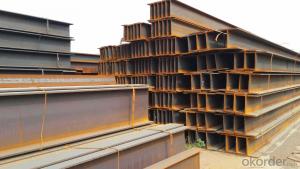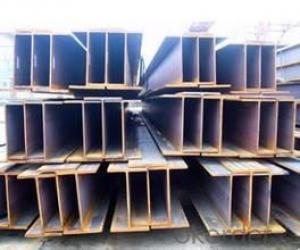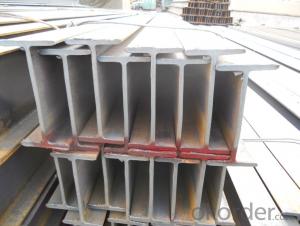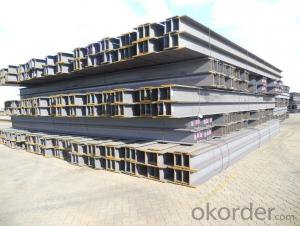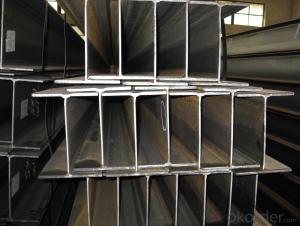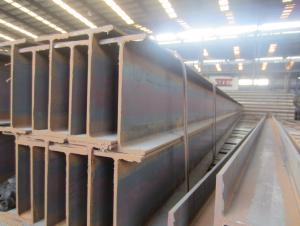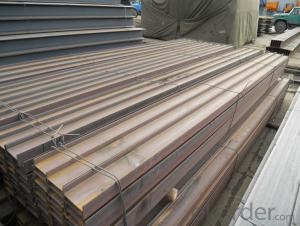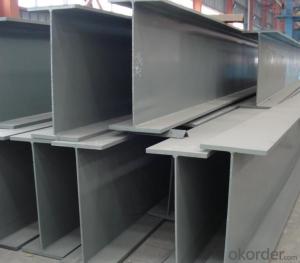Carbon steel H BEAM for construction JIS SS400
- Loading Port:
- Tianjin
- Payment Terms:
- TT or LC
- Min Order Qty:
- 25 m.t.
- Supply Capability:
- 100000 m.t./month
OKorder Service Pledge
OKorder Financial Service
You Might Also Like
Product Description:
OKorder is offering carbon steel H BEAM for construction JIS SS400 at great prices with worldwide shipping. Our supplier is a world-class manufacturer of steel, with our products utilized the world over. OKorder annually supplies products to European, North American and Asian markets. We provide quotations within 24 hours of receiving an inquiry and guarantee competitive prices.
Product Applications:
Carbon steel H BEAM are ideal for structural applications and are widely used in the construction of buildings and bridges, and the manufacturing, petrochemical, and transportation industries.
Product Advantages:
OKorder's H Beam are durable, strong, and resist corrosion.
Main Product Features:
· Premium quality
· Prompt delivery & seaworthy packing (30 days after receiving deposit)
· Corrosion resistance
· Can be recycled and reused
· Mill test certification
· Professional Service
· Competitive pricing
Product Specifications:
1. Standard: JIS 3192
2. Grade: SS400 or Equivalent
3. Length: 10m, 12m as following table
4. Invoicing on theoretical weight or actual weight as customer request
5.Payment: TT or L/C
Size and Mass of H beam:
| Size (mm) | Mass (Kg/m) | Size (mm) | Mass (Kg) |
| 198*99*4.5 | 17.8 | 194*150*6 | 29.9 |
| 200*100*5.5 | 20.9 | 200*200*8 | 49.9 |
FAQ:
Q1: How soon can we receive the product after purchase?
A1: Within three days of placing an order, we will begin production. The specific shipping date is dependent upon international and government factors, but is typically 7 to 10 workdays.
Q2: Can stainless steel rust?
A2: Stainless does not "rust" as you think of regular steel rusting with a red oxide on the surface that flakes off. If you see red rust it is probably due to some iron particles that have contaminated the surface of the stainless steel and it is these iron particles that are rusting. Look at the source of the rusting and see if you can remove it from the surface.
Images:
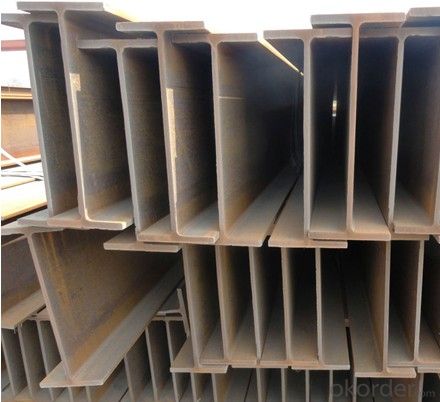
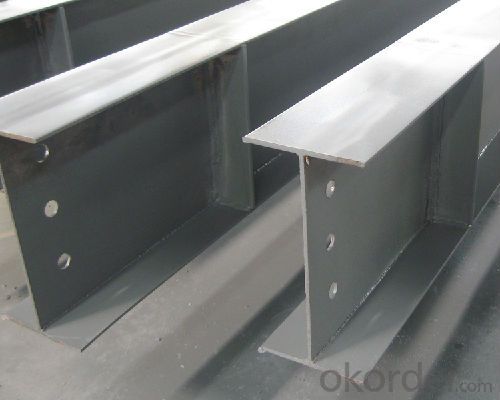
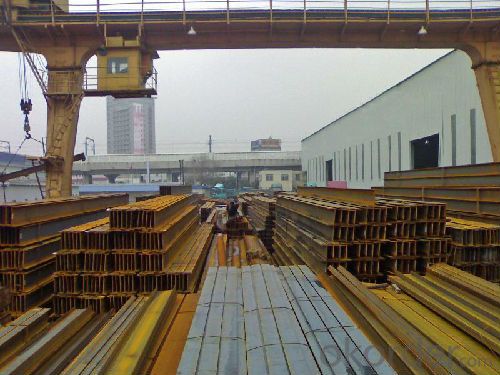
- Q:Can steel H-beams be used for supporting elevated water tanks?
- Yes, steel H-beams can be used for supporting elevated water tanks. Steel H-beams are commonly used in construction for their high strength and load-bearing capacity. They are capable of providing the necessary structural support required for elevated water tanks. The H-beams can be designed and engineered to handle the weight of the water tank, ensuring the stability and safety of the structure. Additionally, steel beams are resistant to corrosion, making them a suitable choice for outdoor applications where water tanks are typically located.
- Q:Can steel H-beams be used in hospital buildings?
- Yes, steel H-beams can be used in hospital buildings. They are commonly used in construction due to their strength, durability, and ability to support heavy loads. Steel H-beams provide structural integrity and are often used in critical areas such as columns and beams to ensure the stability and safety of the building.
- Q:What is the process of galvanizing steel H-beams?
- Galvanizing steel H-beams, also known as galvanization, is the method used to protect them from corrosion and rust. To ensure the adhesion of the zinc coating, the H-beams must first be cleaned to remove dirt, oil, or grease. There are various cleaning methods available, including chemical cleaning, abrasive cleaning, and high-pressure water cleaning. Once the beams are clean, they can be either dipped into a molten zinc bath or sprayed with a zinc-rich coating. This creates a protective layer on the surface of the H-beams through metallurgical bonding, which involves the intermingling of zinc and steel molecules to form a strong bond. After the galvanizing process, the H-beams are cooled and inspected for any defects or irregularities. The thickness, uniformity, and adherence of the zinc coating are checked to ensure they meet the required standards. If necessary, repairs or touch-ups are performed before the beams are deemed ready for use. Galvanized steel H-beams offer several advantages, including increased durability, extended lifespan, and enhanced resistance to corrosion. As a result, they are suitable for a wide range of applications, such as construction, infrastructure, and industrial projects. By undergoing the galvanizing process, steel H-beams are protected against environmental factors, such as moisture, humidity, and exposure to chemicals, ensuring their structural integrity and longevity.
- Q:What are the different types of steel H-beam connections used in industrial buildings?
- There are several different types of steel H-beam connections commonly used in industrial buildings. These connections are designed to provide stability and support to the overall structure. Here are some of the most commonly used types: 1. Welded connection: This is the most common type of connection used in industrial buildings. It involves welding the H-beam to other structural members or plates. Welded connections provide excellent strength and rigidity, making them suitable for heavy-duty applications. 2. Bolted connection: In bolted connections, the H-beam is fastened to other structural members using bolts and nuts. This type of connection allows for easier disassembly and reassembly, making it convenient for buildings that may need to be modified or relocated in the future. 3. Pinned connection: Pinned connections allow for rotation at the joint, providing flexibility to the structure. This type of connection is commonly used in situations where movement or vibration needs to be accommodated, such as bridges or buildings located in earthquake-prone areas. 4. Moment connection: Moment connections are designed to transfer both vertical and horizontal forces between the H-beams and other structural members. These connections provide enhanced stability and resistance against bending moments, making them suitable for structures with high loads or complex geometries. 5. Shear connection: Shear connections are used to transfer shear forces between the H-beams and other structural members. These connections are typically designed to resist lateral loads and provide stability to the structure. The choice of H-beam connection type depends on various factors, including the load requirements, structural design, and construction method. Engineers and designers evaluate these factors to determine the most appropriate connection type for each specific application.
- Q:Are steel H-beams resistant to chemical spills?
- The resistance of steel H-beams to chemical spills can vary depending on the specific type of chemical. Steel is well-known for its durability and strength, making it highly resistant to many chemicals. However, there are certain corrosive chemicals that can potentially harm steel over time. To ensure maximum resistance to chemical spills, it is important to consider the properties of the chemicals and their potential impact on steel. For instance, highly corrosive acids or alkalis can gradually weaken the structural integrity of steel H-beams if not properly addressed. In such cases, it may be necessary to implement additional protective measures, such as corrosion-resistant coatings or regular maintenance, to prevent any long-term damage. In conclusion, although steel H-beams generally resist chemical spills, it is crucial to evaluate the specific chemicals involved and take appropriate precautions to maintain their structural integrity and longevity. Seeking advice from experts and adhering to industry standards is highly recommended to ensure proper protection against chemical spills.
- Q:How do steel H-beams perform in terms of noise reduction?
- Steel H-beams are primarily used as structural elements in construction projects, such as for the construction of buildings, bridges, and other infrastructure. In terms of noise reduction, steel H-beams themselves do not provide significant noise insulation properties. Steel is a dense material that is known to conduct sound vibrations easily. This means that if a noise source, such as traffic or machinery, is directly transmitted to a steel H-beam, it will easily travel through the steel and be heard on the other side. Therefore, steel H-beams alone are not effective in reducing noise levels. However, noise reduction can be achieved by implementing additional measures alongside the use of steel H-beams. For example, using insulating materials such as acoustic panels or soundproofing materials can help absorb or block the sound waves, reducing noise transmission through the steel structure. Similarly, adding resilient mounts or isolators between the steel H-beams and other components can help mitigate vibrations and minimize the transmission of noise. In summary, while steel H-beams themselves do not possess inherent noise reduction properties, they can be utilized effectively in combination with other noise reduction measures to create a more acoustically insulated environment.
- Q:What are the design considerations for steel H-beams?
- Design considerations for steel H-beams include factors such as the load requirements, span length, deflection limits, stability, and connection details. The beam's size and shape, material strength, and overall structural integrity are crucial elements to consider. Additionally, factors such as cost, fabrication ease, and transportation should also be taken into account during the design process.
- Q:What is the lifespan of steel H-beams?
- The lifespan of steel H-beams can vary depending on several factors such as the quality of the steel used, the conditions in which the beams are used, and the level of maintenance they receive. Generally, steel H-beams are designed to be durable and long-lasting, making them suitable for various structural applications. If properly manufactured and maintained, steel H-beams can have a lifespan of several decades or even longer. The high strength and structural integrity of steel allow it to withstand heavy loads, extreme weather conditions, and other external factors that can potentially degrade the material over time. However, it is important to note that various factors can contribute to the deterioration of steel H-beams. These factors include exposure to corrosive elements such as moisture, chemicals, and saltwater, as well as structural overload, excessive vibrations, and improper installation or handling. Regular inspections and maintenance are crucial to identify any signs of corrosion, fatigue, or structural damage that may affect the lifespan of the beams. In summary, the lifespan of steel H-beams can be extensive if they are well-manufactured, properly maintained, and used within their design limitations. By implementing appropriate maintenance practices and protecting the beams from adverse conditions, it is possible to extend their lifespan significantly.
- Q:Do steel H-beams require any special maintenance?
- Steel H-beams generally do not require any special maintenance. However, regular inspections to check for any signs of corrosion, cracks, or structural damage are recommended. Cleaning the beams with a mild detergent and water can help remove dirt and debris, but no additional specific maintenance is typically required.
- Q:Can steel H-beams be used in data center construction?
- Yes, steel H-beams can be used in data center construction. Steel H-beams provide excellent structural support and load-bearing capacity, making them suitable for constructing data centers that require robust and secure infrastructure.
1. Manufacturer Overview |
|
|---|---|
| Location | |
| Year Established | |
| Annual Output Value | |
| Main Markets | |
| Company Certifications | |
2. Manufacturer Certificates |
|
|---|---|
| a) Certification Name | |
| Range | |
| Reference | |
| Validity Period | |
3. Manufacturer Capability |
|
|---|---|
| a)Trade Capacity | |
| Nearest Port | |
| Export Percentage | |
| No.of Employees in Trade Department | |
| Language Spoken: | |
| b)Factory Information | |
| Factory Size: | |
| No. of Production Lines | |
| Contract Manufacturing | |
| Product Price Range | |
Send your message to us
Carbon steel H BEAM for construction JIS SS400
- Loading Port:
- Tianjin
- Payment Terms:
- TT or LC
- Min Order Qty:
- 25 m.t.
- Supply Capability:
- 100000 m.t./month
OKorder Service Pledge
OKorder Financial Service
Similar products
New products
Hot products
Hot Searches
Related keywords

